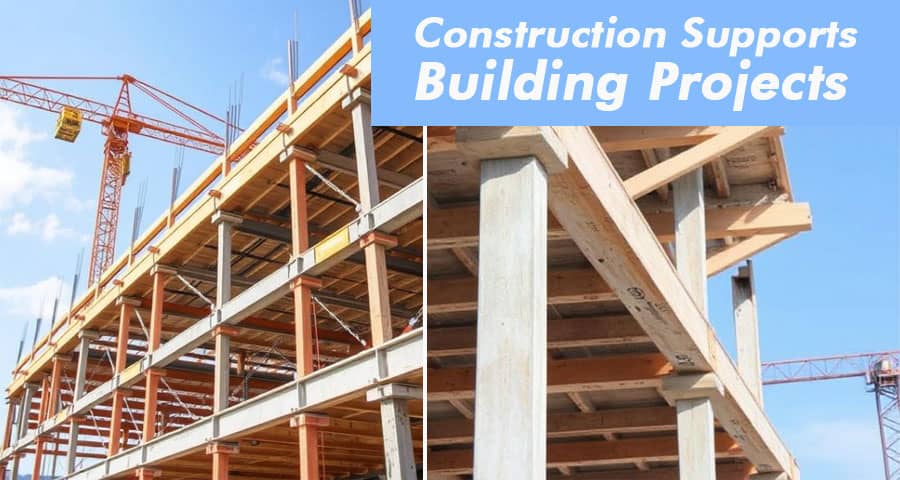Why Are Construction Supports Important in Building Projects?

In the world of modern construction, structural integrity and safety are paramount. At the core of ensuring that safety is a well-executed system of construction supports, also known as temporary supports or shoring systems. These elements serve a critical role throughout various phases of a building project, ensuring that structures are safe, stable, and in accordance with engineering standards.
What Are Construction Supports?
Construction supports are temporary structural elements designed to hold up loads during construction, renovation, or maintenance. They are employed to maintain the stability of various elements - such as walls, floors, or entire frameworks - until the permanent structure can support itself. These systems can include scaffolding, formwork, props, beams, columns, and shores, each tailored to specific needs and load requirements.
Ensuring Worker and Site Safety
One of the primary reasons construction supports are indispensable is because they protect workers and equipment from unexpected structural collapses. During phases like excavation, formwork pouring, or upper-story construction, building elements often lack the self-supporting capabilities that completed structures have.
- Properly installed supports prevent shifts or collapses that could lead to injuries or fatalities.
- They create a controlled environment, minimizing risks associated with working at height or around unstable structures.
- Compliance with OSHA and international safety standards often mandates the use of certified support systems.
Maintaining Structural Integrity During Construction
Buildings are erected in stages. Before a beam, slab, or wall can carry loads independently, it requires temporary stabilization. Construction supports make it possible to:
- Prevent cracking or shifting of freshly poured concrete.
- Maintain alignment and positioning of steel and timber components.
- Support the weight of materials, tools, and personnel as work progresses.
In multistory projects, load distribution becomes even more critical. Shoring systems ensure that load transfer happens safely without exerting stress on unfinished or weak points in the structure.
Types of Construction Supports and Their Applications
There is a wide array of construction support systems, each designed for specific uses. Understanding these types helps builders select the right solution for each phase of a project.
1. Scaffolding
Used primarily to provide access to elevated areas, scaffolding is vital for tasks such as painting, bricklaying, or cladding. It also plays a support role by allowing safe positioning and movement of workers and tools.
2. Shoring Systems
Shoring provides temporary reinforcement to walls, ceilings, and trenches. There are several types:
- Raking Shores: Diagonal supports for unstable walls.
- Flying Shores: Horizontal supports between two adjacent walls.
- Dead Shores: Vertical supports beneath sagging beams or floors.
3. Formwork Supports
These are used to hold freshly poured concrete in place until it cures and gains sufficient strength. Formwork includes:
- Vertical props
- Horizontal beams
- Adjustable steel supports
4. Falsework
A complex system of temporary structures, falsework is used to support arches, bridges, and complex formworks during assembly.
Economic Benefits of Proper Construction Supports
While some may view supports as an added expense, they are actually cost-saving in the long run. Here's how:
- Prevent costly delays caused by structural failures or accidents.
- Reduce the likelihood of legal liabilities from site incidents.
- Increase efficiency by enabling multiple phases of construction to run simultaneously and safely.
Investing in durable, reusable support systems also improves overall project sustainability and reduces material waste.
Regulatory Compliance and Industry Standards
Adhering to local and international building codes requires the use of properly installed and inspected construction supports. Engineers and project managers must ensure that:
- All supports meet load-bearing capacity requirements.
- Inspections are performed regularly and documented.
- Any adjustments or replacements follow established safety guidelines.
Non-compliance not only jeopardizes worker safety but also puts the entire project at risk of legal shutdowns and penalties.
Innovations in Support Technologies
The industry has seen a surge in technological advancements that enhance the design and use of construction supports. These include:
- Adjustable steel props that offer better load flexibility.
- Lightweight composite materials for easy transport and setup.
- Digital modeling software that simulates load distribution and support requirements.
Modern construction projects now integrate BIM (Building Information Modeling) systems to strategically place supports where they are most effective.
Environmental Considerations
Today's builders are also responsible for reducing the environmental impact of their methods. Construction supports play a role here by:
- Promoting the use of modular, reusable systems.
- Reducing the need for excessive raw material consumption.
- Supporting faster builds that cut down on energy use and emissions.
Training and Proper Use
Even the best supports are only effective when used correctly. Therefore, on-site crews must receive proper training in:
- Installation and dismantling procedures
- Load assessment and distribution
- Emergency response in case of failure
Regular training ensures that systems are not only efficient but also safe and compliant with regulatory mandates.
Conclusion: An Indispensable Element of Building Success
The role of construction supports in building projects cannot be overstated. From safeguarding human lives to preserving structural integrity, these systems form the invisible backbone of every successful construction endeavor. As building designs become more complex and ambitious, the demand for intelligent, efficient support systems will only continue to rise.
Please watch the short video for more information
